Wikipedia:Picture of the day/November 2018
|
Featured picture tools: |
These featured pictures, as scheduled below, appeared as the picture of the day (POTD) on the English Wikipedia's Main Page in November 2018. Individual sections for each day on this page can be linked to with the day number as the anchor name (e.g. [[Wikipedia:Picture of the day/November 2018#1]] for November 1).
You can add an automatically updating POTD template to your user page using {{Pic of the day}} (version with blurb) or {{POTD}} (version without blurb). For instructions on how to make custom POTD layouts, see Wikipedia:Picture of the day.Purge server cache
November 1

|
|
The Adélie penguin (Pygoscelis adeliae) is a species of penguin common along the entire Antarctic coast, which is their only residence. They are named after the French Antarctic territory of Adélie Land, which is in turn named for Adèle Dumont d'Urville. She was the wife of French explorer Jules Dumont d'Urville, who discovered these penguins in 1840. Adélie penguins are the most widely spread of the penguin species, and obtain their food by both predation and foraging. Their diet is mainly krill and fish. Photograph: Jason Auch
Recently featured:
|
November 2
Subpage 1
.jpg/340px-AUS-3b-Commonwealth_of_Australia-10_Shillings_(1918).jpg)
|
Banknotes of the Australian pound were first issued by numerous private banks in Australia, starting with the Bank of New South Wales in 1817. Acceptance of private bank notes was not made compulsory by legal tender laws but they were widely used and accepted. The Queensland government issued treasury notes (1866–1869) and banknotes (1893–1910) which were legal tender in Queensland. The New South Wales government issued a limited series of Treasury Notes in 1893. The Commonwealth government passed an Act in 1910 which prohibited the issue of banknotes by private banks, and established Commonwealth powers to issue, re-issue, and cancel Australian notes. These notes were initially issued by the Australian Treasury, and then by the Commonwealth Bank from 1920. The Australian pound was replaced by the Australian dollar in 1966. This note, denominated ten shillings, is part of the 1918 series. See other denominations: £1 (1918) · £5 (1918) · £10 (1918) · £20 (1918) · £50 (1918) · £100 (1918) · Half sovereign (1923) · £1 (1923) · £5 (1924) · £10 (1925) Banknote: Commonwealth of Australia.
Recently featured:
|
Subpage 2
.jpg/340px-AUS-4d-Commonwealth_of_Australia-One_Pound_(1918).jpg)
|
Banknotes of the Australian pound were first issued by numerous private banks in Australia, starting with the Bank of New South Wales in 1817. Acceptance of private bank notes was not made compulsory by legal tender laws but they were widely used and accepted. The Queensland government issued treasury notes (1866–1869) and banknotes (1893–1910) which were legal tender in Queensland. The New South Wales government issued a limited series of Treasury Notes in 1893. The Commonwealth government passed an Act in 1910 which prohibited the issue of banknotes by private banks, and established Commonwealth powers to issue, re-issue, and cancel Australian notes. These notes were initially issued by the Australian Treasury, and then by the Commonwealth Bank from 1920. The Australian pound was replaced by the Australian dollar in 1966. This note, denominated one pound, is part of the 1918 series. See other denominations: 10 shillings (1918) · £5 (1918) · £10 (1918) · £20 (1918) · £50 (1918) · £100 (1918) · Half sovereign (1923) · £1 (1923) · £5 (1924) · £10 (1925) Banknote: Commonwealth of Australia
Recently featured:
|
Subpage 3
.jpg/340px-AUS-5c-Commonwealth_of_Australia-5_Pounds_(1918).jpg)
|
Banknotes of the Australian pound were first issued by numerous private banks in Australia, starting with the Bank of New South Wales in 1817. Acceptance of private bank notes was not made compulsory by legal tender laws but they were widely used and accepted. The Queensland government issued treasury notes (1866–1869) and banknotes (1893–1910) which were legal tender in Queensland. The New South Wales government issued a limited series of Treasury Notes in 1893. The Commonwealth government passed an Act in 1910 which prohibited the issue of banknotes by private banks, and established Commonwealth powers to issue, re-issue, and cancel Australian notes. These notes were initially issued by the Australian Treasury, and then by the Commonwealth Bank from 1920. The Australian pound was replaced by the Australian dollar in 1966. This note, denominated five pounds, is part of the 1918 series. See other denominations: 10 shillings (1918) · £1 (1918) · £10 (1918) · £20 (1918) · £50 (1918) · £100 (1918) · Half sovereign (1923) · £1 (1923) · £5 (1924) · £10 (1925) Banknote: Commonwealth of Australia
Recently featured:
|
Subpage 4
.jpg/340px-AUS-6b-Commonwealth_of_Australia-10_Pounds_(1918).jpg)
|
Banknotes of the Australian pound were first issued by numerous private banks in Australia, starting with the Bank of New South Wales in 1817. Acceptance of private bank notes was not made compulsory by legal tender laws but they were widely used and accepted. The Queensland government issued treasury notes (1866–1869) and banknotes (1893–1910) which were legal tender in Queensland. The New South Wales government issued a limited series of Treasury Notes in 1893. The Commonwealth government passed an Act in 1910 which prohibited the issue of banknotes by private banks, and established Commonwealth powers to issue, re-issue, and cancel Australian notes. These notes were initially issued by the Australian Treasury, and then by the Commonwealth Bank from 1920. The Australian pound was replaced by the Australian dollar in 1966. This note, denominated ten pounds, is part of the 1918 series. See other denominations: 10 shillings (1918) · £1 (1918) · £5 (1918) · £20 (1918) · £50 (1918) · £100 (1918) · Half sovereign (1923) · £1 (1923) · £5 (1924) · £10 (1925) Banknote: Commonwealth of Australia
Recently featured:
|
Subpage 5
.jpg/340px-AUS-7b-Commonwealth_of_Australia-20_Pounds_(1918).jpg)
|
Banknotes of the Australian pound were first issued by numerous private banks in Australia, starting with the Bank of New South Wales in 1817. Acceptance of private bank notes was not made compulsory by legal tender laws but they were widely used and accepted. The Queensland government issued treasury notes (1866–1869) and banknotes (1893–1910) which were legal tender in Queensland. The New South Wales government issued a limited series of Treasury Notes in 1893. The Commonwealth government passed an Act in 1910 which prohibited the issue of banknotes by private banks, and established Commonwealth powers to issue, re-issue, and cancel Australian notes. These notes were initially issued by the Australian Treasury, and then by the Commonwealth Bank from 1920. The Australian pound was replaced by the Australian dollar in 1966. This note, denominated twenty pounds, is part of the 1918 series. See other denominations: 10 shillings (1918) · £1 (1918) · £5 (1918) · £10 (1918) · £50 (1918) · £100 (1918) · Half sovereign (1923) · £1 (1923) · £5 (1924) · £10 (1925) Banknote: Commonwealth of Australia.
Recently featured:
|
Subpage 6
.jpg/340px-AUS-8c-Commonwealth_of_Australia-50_Pounds_(1918).jpg)
|
Banknotes of the Australian pound were first issued by numerous private banks in Australia, starting with the Bank of New South Wales in 1817. Acceptance of private bank notes was not made compulsory by legal tender laws but they were widely used and accepted. The Queensland government issued treasury notes (1866–1869) and banknotes (1893–1910) which were legal tender in Queensland. The New South Wales government issued a limited series of Treasury Notes in 1893. The Commonwealth government passed an Act in 1910 which prohibited the issue of banknotes by private banks, and established Commonwealth powers to issue, re-issue, and cancel Australian notes. These notes were initially issued by the Australian Treasury, and then by the Commonwealth Bank from 1920. The Australian pound was replaced by the Australian dollar in 1966. This note, denominated fifty pounds, is part of the 1918 series. See other denominations: 10 shillings (1918) · £1 (1918) · £5 (1918) · £10 (1918) · £20 (1918) · £100 (1918) · Half sovereign (1923) · £1 (1923) · £5 (1924) · £10 (1925) Banknote: Commonwealth of Australia.
Recently featured:
|
Subpage 7
.jpg/340px-AUS-9c-Commonwealth_of_Australia-100_Pounds_(1918).jpg)
|
Banknotes of the Australian pound were first issued by numerous private banks in Australia, starting with the Bank of New South Wales in 1817. Acceptance of private bank notes was not made compulsory by legal tender laws but they were widely used and accepted. The Queensland government issued treasury notes (1866–1869) and banknotes (1893–1910) which were legal tender in Queensland. The New South Wales government issued a limited series of Treasury Notes in 1893. The Commonwealth government passed an Act in 1910 which prohibited the issue of banknotes by private banks, and established Commonwealth powers to issue, re-issue, and cancel Australian notes. These notes were initially issued by the Australian Treasury, and then by the Commonwealth Bank from 1920. The Australian pound was replaced by the Australian dollar in 1966. This note, denominated 100 pounds, is part of the 1918 series. See other denominations: 10 shillings (1918) · £1 (1918) · £5 (1918) · £10 (1918) · £20 (1918) · £50 (1918) · Half sovereign (1923) · £1 (1923) · £5 (1924) · £10 (1925) Banknote: Commonwealth of Australia.
Recently featured:
|
Subpage 8
.jpg/340px-AUS-10-Commonwealth_Bank_of_Australia-Half_Sovereign_(1923).jpg)
|
Banknotes of the Australian pound were first issued by numerous private banks in Australia, starting with the Bank of New South Wales in 1817. Acceptance of private bank notes was not made compulsory by legal tender laws but they were widely used and accepted. The Queensland government issued treasury notes (1866–1869) and banknotes (1893–1910) which were legal tender in Queensland. The New South Wales government issued a limited series of Treasury Notes in 1893. The Commonwealth government passed an Act in 1910 which prohibited the issue of banknotes by private banks, and established Commonwealth powers to issue, re-issue, and cancel Australian notes. These notes were initially issued by the Australian Treasury, and then by the Commonwealth Bank from 1920. The Australian pound was replaced by the Australian dollar in 1966. This note, denominated one half sovereign, is part of the 1923 series. See other denominations: 10 shillings (1918) · £1 (1918) · £5 (1918) · £10 (1918) · £20 (1918) · £50 (1918) · £100 (1918) · £1 (1923) · £5 (1924) · £10 (1925) Banknote: Commonwealth Bank of Australia.
Recently featured:
|
Subpage 9
.jpg/340px-AUS-11b-Commonwealth_Bank_of_Australia-One_Pound_(1923).jpg)
|
Banknotes of the Australian pound were first issued by numerous private banks in Australia, starting with the Bank of New South Wales in 1817. Acceptance of private bank notes was not made compulsory by legal tender laws but they were widely used and accepted. The Queensland government issued treasury notes (1866–1869) and banknotes (1893–1910) which were legal tender in Queensland. The New South Wales government issued a limited series of Treasury Notes in 1893. The Commonwealth government passed an Act in 1910 which prohibited the issue of banknotes by private banks, and established Commonwealth powers to issue, re-issue, and cancel Australian notes. These notes were initially issued by the Australian Treasury, and then by the Commonwealth Bank from 1920. The Australian pound was replaced by the Australian dollar in 1966. This note, denominated one pound, is part of the 1923 series. See other denominations: 10 shillings (1918) · £1 (1918) · £5 (1918) · £10 (1918) · £20 (1918) · £50 (1918) · £100 (1918) · Half sovereign (1923) · £5 (1924) · £10 (1925) Banknote: Commonwealth Bank of Australia.
Recently featured:
|
Subpage 10
.jpg/340px-AUS-13a-Commonwealth_Bank_of_Australia-5_Pounds_(1924).jpg)
|
Banknotes of the Australian pound were first issued by numerous private banks in Australia, starting with the Bank of New South Wales in 1817. Acceptance of private bank notes was not made compulsory by legal tender laws but they were widely used and accepted. The Queensland government issued treasury notes (1866–1869) and banknotes (1893–1910) which were legal tender in Queensland. The New South Wales government issued a limited series of Treasury Notes in 1893. The Commonwealth government passed an Act in 1910 which prohibited the issue of banknotes by private banks, and established Commonwealth powers to issue, re-issue, and cancel Australian notes. These notes were initially issued by the Australian Treasury, and then by the Commonwealth Bank from 1920. The Australian pound was replaced by the Australian dollar in 1966. This note, denominated five pounds, is part of the 1924 series. See other denominations: 10 shillings (1918) · £1 (1918) · £5 (1918) · £10 (1918) · £20 (1918) · £50 (1918) · £100 (1918) · Half sovereign (1923) · £1 (1923) · £10 (1925) Banknote: Commonwealth Bank of Australia.
Recently featured:
|
Subpage 11
.jpg/340px-AUS-14-Commonwealth_Bank_of_Australia-10_Pounds_(1925).jpg)
|
Banknotes of the Australian pound were first issued by numerous private banks in Australia, starting with the Bank of New South Wales in 1817. Acceptance of private bank notes was not made compulsory by legal tender laws but they were widely used and accepted. The Queensland government issued treasury notes (1866–1869) and banknotes (1893–1910) which were legal tender in Queensland. The New South Wales government issued a limited series of Treasury Notes in 1893. The Commonwealth government passed an Act in 1910 which prohibited the issue of banknotes by private banks, and established Commonwealth powers to issue, re-issue, and cancel Australian notes. These notes were initially issued by the Australian Treasury, and then by the Commonwealth Bank from 1920. The Australian pound was replaced by the Australian dollar in 1966. This note, denominated ten pounds, is part of the 1925 series. See other denominations: 10 shillings (1918) · £1 (1918) · £5 (1918) · £10 (1918) · £20 (1918) · £50 (1918) · £100 (1918) · Half sovereign (1923) · £1 (1923) · £5 (1924) Banknote: Commonwealth Bank of Australia.
Recently featured:
|
November 3

|
Barbara Jordan (1936–1996) was an American lawyer, educator and politician who was a leader of the civil rights movement. A Democrat, she was the first African American elected to the Texas Senate after Reconstruction and the first Southern African-American woman elected to the United States House of Representatives. In 1974 she made an influential televised speech before the House Judiciary Committee supporting the impeachment process against Richard Nixon. She was awarded the Presidential Medal of Freedom by Bill Clinton in 1994. Photograph: Uncredited (U.S. Congress). Restoration: Adam Cuerden.
Recently featured:
|
November 4

|
Religion saved by Spain is an oil on canvas painting produced between 1572 and 1575 by the Venetian school artist Titian, commemorating the Battle of Lepanto. It is an allegory, portraying Spain as a woman in a dramatic landscape, wielding a shield and spear. The Turkish threat is shown by a man wearing a turban in a chariot with two horses on the sea. Christianity is depicted as a woman falling on her knees, threatened not only by the Turks but also by Protestantism, represented by snakes. The painting now hangs in the Prado Museum in Madrid. Painting: Titian
Recently featured:
|
November 5
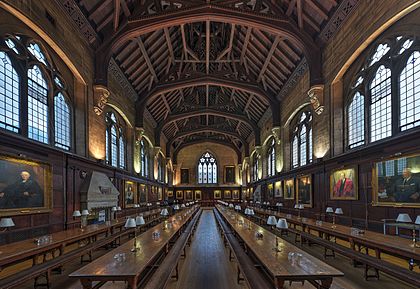
|
|
Balliol College is one of the constituent colleges of the University of Oxford in England. One of Oxford's oldest colleges, it was founded in around 1263 by John I de Balliol, a rich landowner from Barnard's Castle in County Durham, who provided the foundation and endowment for the college. When de Balliol died in 1269 his wife, Dervorguilla, continued his work in setting up the college, providing a further endowment and writing the statutes. Among the college's alumni are Harald V of Norway and former prime ministers H. H. Asquith, Harold Macmillan, and Edward Heath. John Wycliffe, who translated the Bible into English, was Master of the college in the 1360s. This picture depicts the college's dining hall which was designed by Alfred Waterhouse and built in 1877. The hall features a Henry Willis organ. Photograph: David Iliff
Recently featured:
|
November 6

|
|
C/2014 Q2 (Lovejoy) is a long-period comet discovered in 2014 by Australian astronomer Terry Lovejoy using a 0.2-meter (8 in) Schmidt–Cassegrain telescope. It was discovered at apparent magnitude 15 in the southern constellation of Puppis, and is the fifth comet discovered by Lovejoy. Its blue-green glow is the result of organic molecules and water released by the comet fluorescing under the harsh UV and optical light of the sun as it passes through space. Photograph: John Vermette
Recently featured:
|
November 7

|
|
Ho Chi Minh City, also known by its former name of Saigon, is a city in Vietnam. With a municipal population of over 8.4 million, and a metropolitan area of around 12 million people, it is the largest city in the country. The earliest settlement in the area was a Funan temple, founded in the 4th century AD. A settlement called Baigaur, part of the Cham Empire, was established on the site in the 11th century and renamed to Prey Nokor when the empire was invaded by the Khmer people. The Khmer king began allowing Vietnamese people to live in the city from 1623, and it became a Vietnamese city under the leadership of Nguyễn Hữu Cảnh in 1698. Initially called Gia Dinh, the Vietnamese city became Saigon in the 18th century. The city was part of the French Empire from 1862 and after World War II became capital of the state of South Vietnam. The city was taken over by North Vietnam in 1975, an event which ended the Vietnam War. Photograph: Diego Delso
Recently featured:
|
November 8
.jpg/300px-Anna_Klumpke_-_Portrait_of_Rosa_Bonheur_(1898).jpg)
|
Rosa Bonheur (1822–1899) was a French artist, painter of animals, and sculptor, known for her artistic realism. Born in Bordeaux into a family of artists, she moved to Paris at the age of six. Spending much of her time drawing from an early age, Bonheur had a difficult childhood and was expelled from several schools, eventually being trained as a painter by her father. A French government commission led to Bonheur's first great success, Ploughing in the Nivernais, exhibited in 1849. In 1855 she completed The Horse Fair, which is regarded as her most famous work. This oil-on-canvas portrait of Bonheur, titled Rosa Bonheur, was completed in 1898 by American artist Anna Elizabeth Klumpke, a long-time admirer of Bonheur's work. Painting: Anna Klumpke
Recently featured:
|
November 9
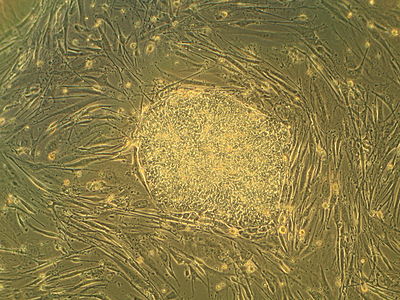
|
Embryonic stem cells are pluripotent cells derived from the embryo of humans and other animals during the blastocyst stage of development, before implantation. In human embryos this stage is reached 4–5 days after fertilization, at which time they consist of 50–150 cells. The cells are the subject of considerable research into potential therapeutic use, including the treatment of diabetes and heart disease. They are also studied for clinical therapies, models of genetic disorders, and cellular/DNA repair. However, adverse effects in the research and clinical processes such as tumours and unwanted immune responses have been reported. Isolating the inner cell mass results in destruction of the blastocyst, a process which raises ethical issues, including whether or not embryos at the pre-implantation stage should have the same moral considerations as embryos in the post-implantation stage of development. Photograph: Ryddragyn
Recently featured:
|
November 10
.jpg/390px-Expedition_42_Soyuz_TMA-14M_Landing_(201503120102HQ).jpg)
|
Soyuz TMA-14M was a 2014–15 flight by a Russian Soyuz spacecraft to the International Space Station (ISS). Its crew, members of Expedition 41, were Russians Aleksandr Samokutyayev and Yelena Serova, and American Barry E. Wilmore. After launching aboard a Soyuz-FG rocket from the Baikonur Cosmodrome, the spacecraft reached low Earth orbit approximately nine minutes after lift-off. It docked with the ISS's Poisk module just under six hours after launch, following a four-orbit rendezvous. TMA-14M remained docked to the ISS for just under six months before departing to return Samokutyayev, Serova and Wilmore to Earth. After undocking the spacecraft deorbited and began its descent (pictured), with the mission crew landing safely just over three hours later. Photograph: NASA/Bill Ingalls
Recently featured:
|
November 11
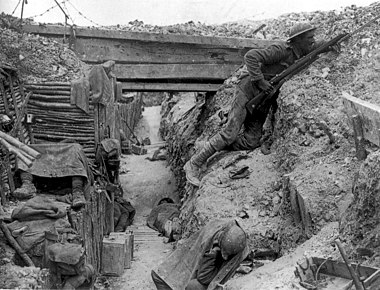
|
World War I was a global war originating in Europe that lasted from 28 July 1914 to 11 November 1918. More than 70 million military personnel participated, making it one of the largest wars in history. An estimated nine million combatants and seven million civilians died as a direct result of the war with losses exacerbated by technological developments and the tactical stalemate caused by trench warfare (pictured). The war is also considered a contributory factor in a number of genocides and the 1918 influenza epidemic, which caused between 50 and 100 million deaths worldwide. Unresolved rivalries at the end of the conflict contributed to the outbreak of World War II about twenty years later. Photograph: Lt. J. W. Brooke
Recently featured:
|
November 12
_2.jpg/280px-Rock_hyrax_(Procavia_capensis)_2.jpg)
|
The rock hyrax (Procavia capensis), also known as the dassie, is one of four living species of the order Hyracoidea, and the only living species in its genus. Like all hyraxes, it is a medium-sized terrestrial mammal between 4 kilograms (9 lb) and 5 kilograms (11 lb) in mass, with short ears and tail. The rock hyrax is found across Africa and the Middle East, at elevations up to 4,200 metres (13,800 ft). It resides in habitats with rock crevices which it uses to escape from predators. Along with the other hyrax species and the manatee, these are the animals most closely related to the elephant. Photograph: Charles J. Sharp
Recently featured:
|
November 13

|
The Basilica of the National Shrine of Our Lady of Aparecida is a Catholic basilica located in the Brazilian city of Aparecida. According to local tradition, a group of fishermen caught a statue of the Virgin Mary in their nets in 1717, a find which considerably improved their subsequent catches. One of the fishermen kept the statue at his home, which became a popular site for pilgrims. A small chapel was built to house it, but was replaced by successively larger churches as the statue's popularity grew. The present building was built from 1955, and houses 45,000 people. Photograph: Valter Campanato, Agência Brasil.
Recently featured:
|
November 14

|
A Meat Stall with the Holy Family Giving Alms is a painting by the Netherlandish artist Pieter Aertsen, completed in 1551. It depicts a peasant market, with an abundance of meats and other foods. In the background it shows a scene from the biblical theme of the flight into Egypt, where the Virgin Mary is seen stopped on the road, giving alms to the poor. The painting is now held by the North Carolina Museum of Art. Painting: Pieter Aertsen.
Recently featured:
|
November 15
.jpg/300px-GDR-1-Soviet_Germany-1_Deutsche_Mark_(1948).jpg)
|
The Rentenmark was a currency introduced on 15 November 1923 in Weimar Germany after the value of the previous currency had been destroyed by hyperinflation. The banknote shown at left was printed in 1937 or later. It bears an adhesive coupon attached by the East German government in 1948, extending its validity while new East German mark banknotes were being printed. Banknote: Weimar Republic, National Numismatic Collection, National Museum of American History |
November 16

|
|
Senja is an island in the county of Troms in Norway. It has an area of 1,586 square kilometres (612 sq mi) and a population of 7,864 as of 2017. Most of the residents live along the eastern coast of the island, with Silsand being the largest urban area. Senja sits northeast of the Vesterålen archipelago, surrounded by the Norwegian Sea to the northwest, the Malangen fjord to the northeast, the Gisundet strait to the east, the Solbergfjorden to the southeast, the Vågsfjorden to the south, and the Andfjorden to the west. Ånderdalen National Park is located in the southern part of the island. This picture shows a panoramic view from a ridge located between the Segla and Hesten mountain summits on Senja. The fjord to the left is Øyfjorden and the fjord to the right is Mefjorden. Photograph: Simo Räsänen |
November 17

|
The Dust Bowl was a period of severe dust storms that greatly damaged the ecology and agriculture of the American and Canadian prairies during the 1930s. Drought and a failure to apply dryland farming methods to prevent wind erosion caused the phenomenon. The drought came in three waves, 1934, 1936, and 1939–1940, but some regions of the high plains experienced drought conditions for as many as eight years. This photograph, titled Broke, baby sick, and car trouble!, was taken by Dorothea Lange in 1937 and depicts a Missouri migrant family's jalopy stuck near Tracy, California. Photograph: Dorothea Lange. Restoration: Adam Cuerden.
Recently featured:
|
November 18

|
The William Crooks is a 4-4-0 steam locomotive that was the first locomotive to operate in the U.S. state of Minnesota, beginning in 1861. It was named after William Crooks, the chief mechanical engineer for the St. Paul and Pacific Railroad, who earlier served as a colonel in the 6th Minnesota Volunteer Infantry Regiment during the American Civil War. Crooks laid out the initial ten-mile track between Minneapolis and St. Paul on which the locomotive operated. It was retired from regular service in 1897, but operated special services for several further decades. It is now in the Lake Superior Railroad Museum in Duluth. Photograph: National Photo Company, Restoration: Adam Cuerden
Recently featured:
|
November 19

|
Charles I (19 November 1600 – 30 January 1649) was monarch of the three kingdoms of England, Scotland, and Ireland from 1625 until his execution in 1649. The second son of King James VI of Scotland, he spent most of his life in England after his father inherited the English throne in 1603. His reign was marked by quarrels with the Parliament of England, which sought to curb his royal prerogative. From 1642, Charles fought the armies of the English and Scottish parliaments in the English Civil War. His defeat led to his execution, followed by establishment of a republic called the Commonwealth of England. This painting, titled Equestrian Portrait of Charles I, is an oil-on-canvas work by Charles's Principal Painter in Ordinary, Anthony van Dyck. The portrait, now in the National Gallery in London, is thought to have been painted in about 1637–38, and is one of many portraits of Charles by van Dyck, including several equestrian portraits. Painting: Anthony van Dyck
Recently featured:
|
November 20

|
Trinity College Library is a library serving Trinity College Dublin as well as the wider University of Dublin. It is a legal deposit or copyright library, which means that publishers in Ireland must deposit a copy of all their publications in the library, free of charge. It is also the only Irish library to hold such rights for publications in the United Kingdom. Founded at the same time as the college, in 1592, it received its most famous manuscript, the Book of Kells, from Henry Jones in 1661. Pictured is the Long Room, which is situated in the Old Library building. It was built between 1712 and 1732, has a length of 65 metres (213 ft), and houses 200,000 of the Library's oldest books. Photograph: David Iliff
Recently featured:
|
November 21

|
Still Life with Profile of Laval is an 1886 oil painting by French artist Paul Gauguin. It depicts his friend Charles Laval, in profile, with an assortment of inanimate objects. They met in the summer of 1886, and Laval became Gauguin's pupil shortly afterwards. The ceramic pot in the painting was created by Gauguin himself, one of a collection of ceramic experiments by the artist. He valued these highly, as both artistic objects and sources of income. The pot cannot be located, and may have been destroyed. Still Life with Profile of Laval is in the Indianapolis Museum of Art. Painting: Paul Gauguin
Recently featured:
|
November 22

|
Stephan's Quintet is a visual grouping of five galaxies of which four form the first compact galaxy group ever discovered. The group, visible in the constellation Pegasus, was discovered by Édouard Stephan in 1877 at the Marseille Observatory. The brightest member of the visual grouping is the spiral galaxy NGC 7320 that is shown to have extensive H II regions, identified as red blobs, where active star formation is occurring. Stephan's Quintet is the most studied of all the compact galaxy groups. Image: NASA, ESA, and the Hubble SM4 ERO team.
Recently featured:
|
November 23

|
|
xkcd is a webcomic created in 2005 by American author Randall Munroe. Describing itself as "a webcomic of romance, sarcasm, math, and language", its subjects include statements on life and love as well as mathematical, programming, and scientific in-jokes. Although it has a cast of stick figures, the comic occasionally features landscapes, graphs, and intricate mathematical patterns such as fractals. New cartoons are added three times a week, on Mondays, Wednesdays, and Fridays. This picture is an xkcd cartoon titled Wikipedian Protester, one of several references to Wikipedia which have appeared in the comic. Image: Randall Munroe (xkcd).
Recently featured:
|
November 24
.jpg/300px-Farida_Arriany%2C_c._1960_(signed).jpg)
|
Farida Arriany (24 November 1938 – 15 October 1977), was an Indonesian actress and singer. Born in Bandung, West Java, she made her feature film debut in 1955, taking the role of Sari in Golden Arrow's Kasih Ibu (A Mother's Love). She appeared in eighteen further films in the following six years, including an appearance as Lastri in the 1957 film Anakku Sajang (My Dear Child), for which she won Best Leading Actress at the 1960 Indonesian Film Week. She established her own film company in the 1960s, producing Kami Bangun Hari Esok (We Wake Tomorrow) in 1963, the first Indonesian film shot with CinemaScope. After a period of inactivity in the mid-1960s she appeared in films again from 1969 until her death, including a singing role in Sjumandjaja's Apa jang Kau Tjari, Palupi? (What Are You Seeking, Palupi?) and Wim Umboh's Laki-Laki Tak Bernama (Man Without a Name). Photograph: Tati Studio. Restoration: Chris Woodrich
Recently featured:
|
November 25

|
Parantica aglea, also known as the glassy tiger, is a butterfly found in the Indomalayan realm. It is part of the Danainae group within the family Nymphalidae. There are two subspecies, P. a. aglea and P. a. melanoides. Photograph: Jeevan Jose. Edited by: Christian Ferrer.
Recently featured:
|
November 26
_-_Allegory_of_Fortune_-_Google_Art_Project.jpg/280px-Salvator_Rosa_(Italian)_-_Allegory_of_Fortune_-_Google_Art_Project.jpg)
|
Allegory of Fortune, sometimes also named La Fortuna, is a 1658 or 1659 oil painting by the Italian baroque painter Salvator Rosa. It depicts Fortuna, the goddess of fortune, pouring her gifts on an array of undeserving animals. It breaks with traditional Fortuna depictions in portraying her with eyes uncovered, aware of the recipients of the gifts, rather than with her eyes covered. Painted at the same time as Rosa's essay Babilonia, a satirical condemnation of the papal court, Allegory of Fortune was interpreted initially as an attack on Pope Alexander VII's patronage, with the hogs seen as representing churchmen. He was threatened with imprisonment and excommunicated until being saved by an intervention from the pope's brother, Don Marco Chigi. Painting: Salvator Rosa
Recently featured:
|
November 27
.jpg/430px-Sveti_Stefan_(06).jpg)
|
|
Sveti Stefan is a small islet and five-star hotel on the Adriatic coast of Montenegro, close to the city of Budva. Sveti Stefan was the capital city of the Paštrovići community, which became a protectorate of the Republic of Venice in 1423 having likely been independent since the twelfth century. Following a population decline in the early twentieth century, the Yugoslav authorities relocated the remaining population and converted the islet into a luxury hotel. It became popular with celebrities such as Marilyn Monroe and was used by Novak Djokovic for his wedding in 2014. It is now operated by Aman Resorts. Photograph: Halavar
Recently featured:
|
November 28
.jpg/300px-CZE-17-Republika_Ceskoslovenska-100_Korun_(1920).jpg)
|
A 100 Czechoslovak koruna banknote featuring artwork produced in 1918 by Czech painter Alphonse Mucha (1860–1939). The note shows the image of Slavia, the daughter of Mucha's American patron Charles Crane. Born in Moravia, Mucha moved to Paris in 1888 where he enrolled in the Académie Julian. He rose to fame in 1895 with his poster of actress Sarah Bernhardt for the play Gismonda, which was displayed across Paris. Mucha returned to his homeland with a move to Prague in 1910. He worked there on the The Slav Epic, a series of twenty paintings depicting the history of the Slavic peoples of the world, which became his most important work. Banknote: Alphonse Mucha and the Banking Office of the Ministry of Finance, First Republic of Czechoslovakia.
Recently featured:
|
November 29
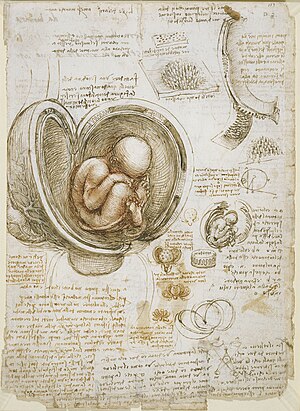
|
Studies of the Fetus in the Womb is a set of two sketches by Leonardo da Vinci, made in around 1511. The studies depict the human fetus inside a dissected uterus. Da Vinci had studied human embryology with the help of anatomist Marcantonio della Torre and saw the fetus within a cadaver. This picture, the first of the two studies, shows the fetus in a breech position. Da Vinci mistakenly drew the placental cotyledons in the vascular walls of the uterus, a trait he had seen in a cow uterus but which is not found in humans. The studies were initially bequeathed to Francesco Melzi, with subsequent owners including Pompeo Leoni and Thomas Howard, 21st Earl of Arundel. Since 1690 they have been housed in the United Kingdom's Royal Collection. Sketch: Leonardo da Vinci
Recently featured:
|
November 30
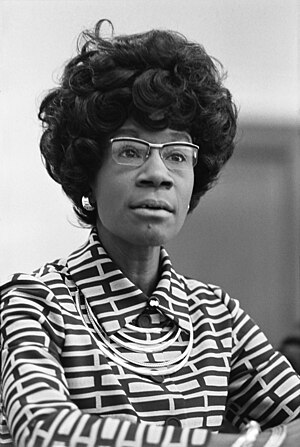
|
Shirley Chisholm (November 30, 1924 – January 1, 2005) was an American politician, educator, and author. In 1968 she became the first black woman elected to the United States Congress, and she represented New York's 12th Congressional District for seven terms from 1969 to 1983. In 1972 she became the first black candidate for a major party's nomination for President of the United States, and the first woman to run for the Democratic Party's presidential nomination. In 2015 Chisholm was posthumously awarded the Presidential Medal of Freedom. Photograph: Thomas J. O'Halloran. Restoration: Adam Cuerden
Recently featured:
|
Picture of the day archives and future dates
